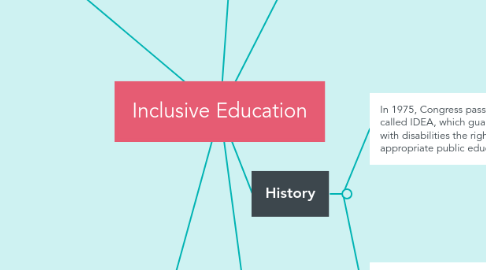Inclusive Education
by Jennifer Bangle


1. “The valuing of diversity within the human community. When inclusive education is fully embraced, we abandon the idea that children have to become “normal” in order to contribute to the world….We begin to look beyond the typical ways of becoming valued members of the community, and in doing so, begin to realize the achievable goal of providing all children with an authentic sense of belonging” (Kunc, 1992).
2. Important Definitions
2.1. Social Model of Disability: suggests that disability is created or comes to light within certain environments.
2.2. Inclusive Classrooms: educational environments in which students with and without disabilities are educated together.
2.3. Therapy Rooms: a place where students are supposed to spend a short time working on a specific skill, performance, or routine before returning to the least restrictive environment (LRE).
2.4. Self-contained Classroom: designed for instructing only students who have disabilities.
2.5. Self-contained or Alternative School: a place where students with similar learning, behavior, or social needs are provided instruction for the duration of the school day.
3. What does Inclusion look like?
3.1. Natural Proportions: in any classroom, the number of students with disabilities should reflect the natural population of students with disabilities in the school.
3.2. Co-Planning: general and special educators must establish a common planning time weekly to brainstorm and design upcoming curriculum units and lessons.
3.3. Co-Teaching: inclusive classrooms often have two teachers with equitable responsibilities for educating all the students. They work together in flexible and coordinated ways.
3.4. Community building and culture: ensures that students feel connected to one another and their teachers. Day or class can start with morning meeting, where students share something with the class.
3.5. Differentiation: a strategy inclusive educators use to respond to various learning needs.
3.6. Students do not leave to learn: students are not removed from the classroom for remediation, but services and supports are brought directly to them.
3.7. Grouping and seating are heterogeneous: students with disabilities should be physically spread out in the classroom.
3.8. Engaging Instruction: learning does not entail large-group lectures where teachers talk while students sit and listen. Learning is engaging and exciting in an inclusive classroom.
4. Inclusive Educators
4.1. In the inclusive class room, teachers collaborate to benefit all students.
4.2. Inclusive educators must be familiar with universal design for instruction, differentiation, and creating inclusive lessons.
4.3. Challenging behaviors decrease in inclusive classrooms when educators engage in humanistic behavioral support
5. History
5.1. In 1975, Congress passed what is now called IDEA, which guarantees all students with disabilities the right to free appropriate public education in the LRE.
5.1.1. Free: all supports and services necessary to education will be paid for at public expense. Appropriate: all students must be provided asisstive technology, aids, and services that allow them to participate. Public education: special education and related services are guaranteed.
5.1.2. LRE (Least restrictive environment): a school district must educate any student with a disability in the regular classroom with appropriate aids and supports, along with the student's peers without disabilities.
5.1.2.1. Under LRE, the general education classroom is preferred and is the first place to be considered for placing a student with a disability before a more restrictive option.

